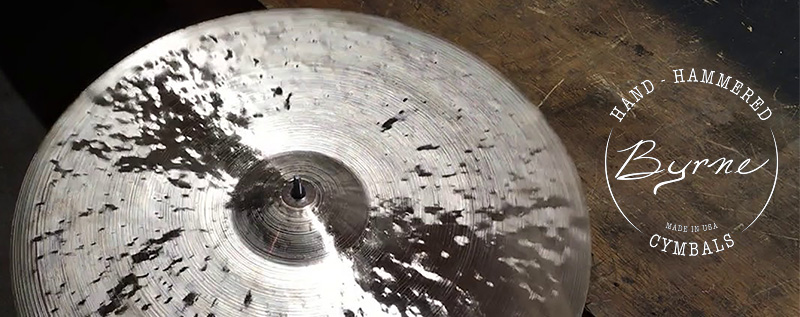Byrne Cymbals
Listen to our Byrne Cymbals here
Here below, you can see our available selection of Byrne cymbals. Remember that at CymbalONE, it is the excact same cymbal on display in the video that is for sale.
About Byrne Cymbals
For more than 25 years, drums have been a huge passion for Ray Byrne. As a child, Ray got his first drum kit (an old Rogers) from his father's best friend, and already at this early stage, his fascination of cymbals began. Ray's fascination with cymbals was so strong that he began experimenting with them by hammering his own into new shapes.
Ray's interest for instruments in general lead him to Roberto-Venn School of Luthiery to become a musical instrument maker where he learned to build and repair guitars. Yet, after some years as a fully-trained guitar maker, he decided to turn back to his childhood's passion: the cymbals. Ray began importing B20 blanks to finish in his own workshop.
From these raw and unfinished bronze plates, Ray shapes and produces every single cymbal. With ample time and attention given to each cymbal, Ray gets the best possible results from the bronze, and he creates the following series:
Vintage Series
Individually, hand-hammered cymbals with smaller areas of original, raw bronze where you can see the marks from the hammer, but still with the top fully turned.
Quarter Turk Series™
Individually, hand-hammered cymbals with a fully turned bottom and a partly turned top, which leaves about a fourth of the cymbal's surface original and raw. This results in a slightly dryer and more articulated sound.
Regardless of which series from Byrne Cymbals you should choose, every single cymbal is completely unique and will therefore stand out from the mass-produced cymbals.
Every cymbal is hammered and turned when an order is placed. They are never just taken down from a shelf and dusted off!

About the production of Byrne Cymbals
Every cymbal starts as a raw plate of B20 bronze, a so-called "blank". These plates are produced in Turkey and are then shipped to the USA.
A "blank" is a raw plate of bronze. It starts as a small lump of bronze, which is flattened numerous times, until it is a large, circular disc. This process of rolling warm bronze shapes the structures in the metal, and it results in a very multi faceted sound.
Rolling
Once the bronze has been rolled out and has got the desired size, the bell is stamped out while still warm. Subsequently, the bronze is reheated, before it is put into a cold basin with water, which tempers the metal and gives it strength.
At this moment, the blank looks most of all as a big, crooked, and beat-up bronze chip with discoloration and soot from the oven.
Hammering
All of these Turkish blanks are then hammered by hand in Ray's workshop in Illinois.
When the cymbal is hammered, Ray controls the shape of the cymbal, and when the hammering is done, the cymbal rests for several days - sometimes weeks.
Rest
Every cymbal gets some time to rest, both if it has been hammered or if it has been turned. This leaves the metal with a chance of working a little by itself, hence achieving the best possible sound. This is important in order to control the tones and controlling the sound of the cymbal in the end. Even efter 24 hours of rest, the tonal difference is like day and night.
Bear in mind, that the process of hammering a cymbal into shape pulls and stretches the metal to such a degree that, at some point, it gets soft and jiggly. The rest provides the cymbal with a chance to regain its natural state of hardness.
The order, in which a cymbal is hammered - from center outwards or the other way around, the pattern, the weight of the hammer -, all plays a part in giving the cymbal its specific tones in the end.
Top-hammering vs. bottom-hammering
After the initial hammering of the top of the cymbal, it is turned, and the hammering continues on the bottom. One can strengthen the curve of the cymbal through circular hammering patterns on the bottom.
Top-hammering vs. bottom-hammering - this choice has a radical impact on the result in the end. A predominantly top-hammered cymbal is firm, whereas a predominantly bottom-hammered cymbal is slack and jiggly.
To fabricate real, hand-hammered cymbals, you have to also hammer the bottom, which is why hand-hammered cymbals will always inevitably be slightly softer than machine-hammered cymbals.
Lathing
In the end, the cymbal is lathed. By lathing, you create small tonal grooves in the surface, and you can thin out the edges of the cymbal. This makes it easier to control a cymbal's general spread and "wash".
Byrne on records
Players like Jay Bellerose and Matt Chamberlain has been recording with Byrne cymbals - Jay on the Alison Kraus & Robert Plant record "Raise the roof", and Matt on the Pistol Annies' album "Interstate Gospel" (if you want to check it out).

